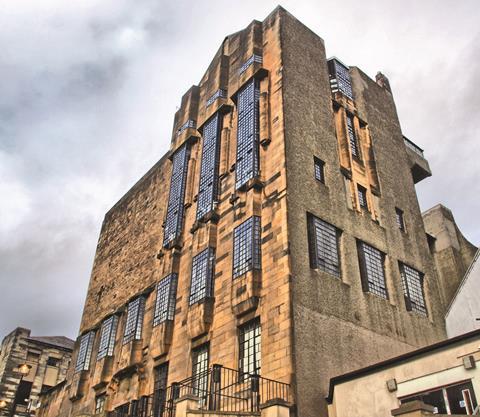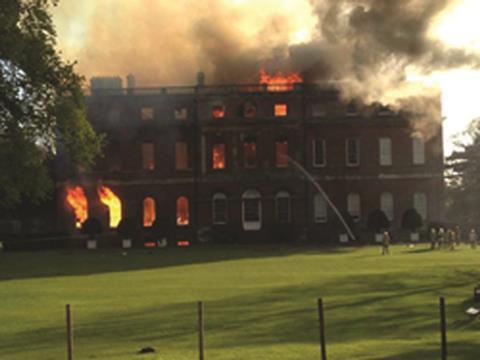Many shopkeepers, unable to return to premises because of dangerous state of the iconic Glasgow School of Art building find they are not covered
Businesses and residents close to the Glasgow School of Art (GSA) have found themselves left out in the cold following the blaze that ripped through the iconic building last month.

the iconic Glasgow School of Art before the fire.
Despite their own premises being directly unaffected by the blaze, the dangerous condition of the Charles Rennie Mackintosh designed building means small firms and shopkeepers are unable to return until its fate is decided.
But unless they have business interruption (BI) insurance that includes denial of access cover, they are unlikely to get any help from insurers.
Other major blazes

Liverpool Arena car park, 2017: cost £20m. Around 1,400 cars were destroyed when a fire ripped through the car park at the Liverpool Arena on New Year’s Eve. Aviva, Markerstudy, LV=, Ageas, NFU Mutual and Tesco waived the excesses on claims made after the incident.
The fire that ripped through the GSA has left only the external walls standing. But besides the damage to the building itself and the neighbouring O2 concert hall, the roof of which collapsed after the fire spread, the blaze has forced the evacuation of many businesses and residents in the streets surrounding the school.
Having moved out due to the risk of being hit by the school’s collapsing walls, they are still locked out of the cordon.
Glasgow Council has hired solicitors Harper Macleod to advise businesses and residents about their insurance headaches. One female resident that Elizabeth Mitchell, a partner at the firm, spoke to went out on the Saturday night after the fire and hasn’t been allowed back home since.
Many of the firms affected are small bars, restaurants and cafes on Sauchiehall Street, one of the city’s main thoroughfares. Many will ‘really struggle’ to remain in business, Mitchell says.
But if their properties are not damaged, many have been told by their insurers that they are not covered.

Royal Clarence Hotel, 2016: Cost £25m. England’s oldest purpose-built hotel was gutted bß≠y a fire which broke out in a nearby art gallery that had been undergoing renovation. The 18th century Exeter building’s owner is planning a new hotel behind a reconstruction of the façade. However the closing off of surrounding streets in the months following the fire caused some businesses to go under.
The insurance woes of Sauchiehall Street’s traders and resident have even been raised on the floor of the House of Commons.
Alison Thewliss, MP for Glasgow Central, raised her constituents’ plight at prime minister’s question time last week. She tells Insurance Times that insurers have turned a deaf ear to their concerns.
“Insurers are saying that it’s ‘too bad’ and they’re trying to fob them back off onto the council.”
Self-employed people living in the area have been particularly hard hit, says Thewliss: “Some constituents are freelancers so they don’t have access to the things they need to do their job.”

Grenfell Tower 2017: Cost up to £1bn. The blaze, which destroyed the Kensington & Chelsea Council tower block resulted in 72 deaths. Norwegian insurer Protector Forsikring ASA, which insured the building, estimated that just the damage to the building and rehousing its residents could cost up to £50m. But this figure could be the tip of the iceberg once compensation for lives lost has been factored in.
A Glasgow Council spokesman says: “One of the issues has been around whether you can claim if your own property has not been fire damaged. Some insurers are telling households that, unless their property was on fire, they won’t support them.”

Clandon Park, near Guildford 2015: Cost £65m. Zurich Municipal was on the hook for the blaze which destroyed 95% of the Grade I listed stately home and its collection of art and furniture. The National Trust is rebuilding the 18th century property.
An ABI spokesman says talks are ongoing with Glasgow Council but that the industry’s response so far follows standard practice after such incidents.
He says: “In situations where people are unable to get to their homes because of an emergency closure or evacuation, it is the norm that the relevant local authority will provide alternative accommodation, with private landlords and housing associations also stepping in. It is rare for individuals’ property insurance to come into play when their home is not damaged.”
Little hope of compensation
Commercial customers may be able to get compensation, but only if they have bought denial of access cover, which is often treated as an add-on to BI policies, the spokesman adds. A Biba spokeswoman says the broker’s body is “not aware of any home insurance that does provide non-damage alternative accommodation cover.”
And hopes of redress stemming from the accident itself will take a long time to bear fruit, she adds.
“Should there prove to be negligence there may be a case for damages. However, this would depend on the ‘remoteness of damage’ and foreseeability in respect of financial losses flowing from a tortuous action.”
Glasgow Council’s building control department has since concluded that the structure is so fragile that three of the school’s four walls will have to be taken down. Luckily, the wall that appears most structurally sound is the ornate front gable that would be the hardest to reconstruct.
Billy Hare, professor in construction management at Glasgow Caledonian University, has estimated that the cost of rebuilding will be ‘at least’ £100m based on the estimated £35m bill for the one-third destroyed in the previous fire.
The greater severity of the damage and the knock-on disruption the incident will have on the surrounding area means that the cost could spiral to £200m, he adds.
Rebuilding and refurbishing always present challenges, says John Melbourne of insurer Ecclesiastical.
The school itself is understood to have been covered by a construction policy issued by the Travelers 5000 Lloyd’s syndicate to Kier, which was contractor on the reconstruction. According to Travelers’ website, the syndicate has a capacity of $75m. Travelers did not respond to requests for comment by Insurance Times. Marsh was broker for Kier, which has had its contract terminated by mutual consent with the GSA.
And it may be months before residents and businesses can reoccupy their properties, warns Hare.
In the meantime, he says: “Residents are shouting for blood and shopkeepers are being driven out of business.”
Insurers may be getting it in the neck now in Glasgow but the city as a whole faces some hard questions about the future of its most treasured building.
The school is keen to retain as much of its original fabric as possible by taking apart the building brick by brick. This process, known as deconstruction, is far more painstaking than the more run of the mill demolition.
But Hare reckons that time is not on the school’s side and that the latter and blunter approach will be required.
He says: “The School of Art is playing the damage down. A more realistic appreciation is needed of what needs to be done.”
The school should demolish the walls apart from the relatively stable front one, Hare says. “You are against the clock and every step of the way there could be a collapse at any moment.”
Hosted by comedian and actor Tom Allen, 34 Gold, 23 Silver and 22 Bronze awards were handed out across an amazing 34 categories recognising brilliance and innovation right across the breadth of UK general insurance.



















































No comments yet